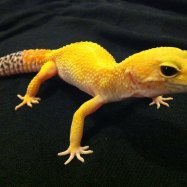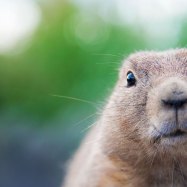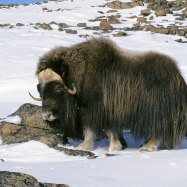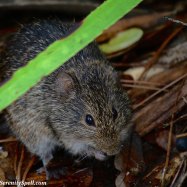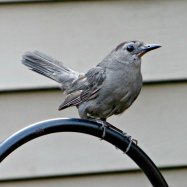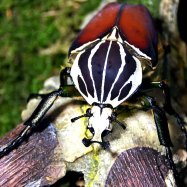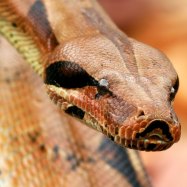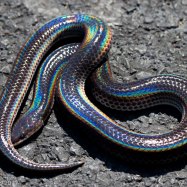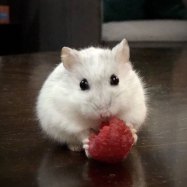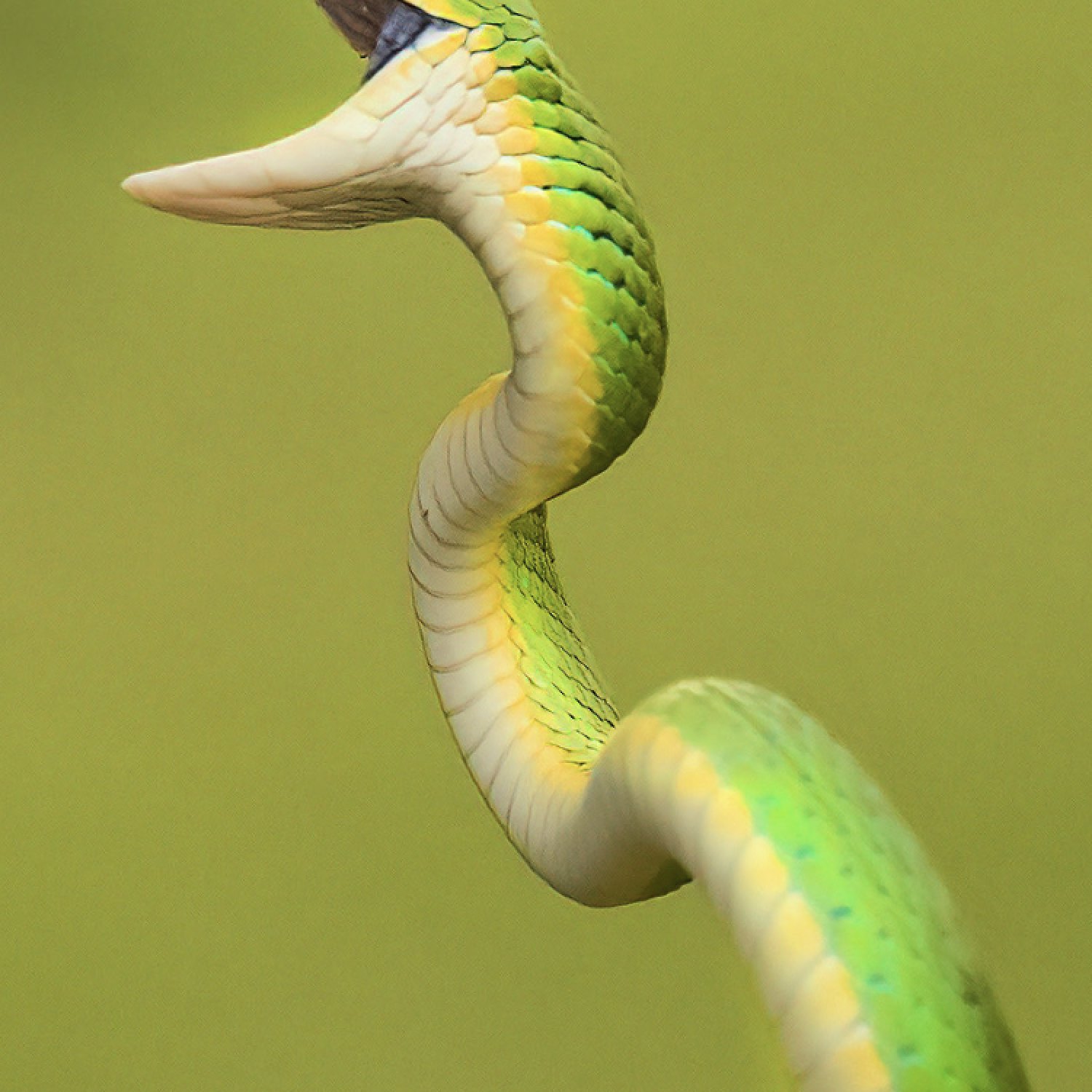
Rough Green Snake
2 to 4 feet (60 to 120 cm)
The Rough Green Snake, found in the Eastern United States, is known for its slender and cylindrical body shape. It can grow to be 2 to 4 feet long and belongs to the Colubridae family. This non-venomous snake is a popular choice for reptile enthusiasts due to its calm demeanor and easy care. #RoughGreenSnake #Colubridae #EasternUS #ReptileLove
Animal Details Summary:
Common Name: Rough Green Snake
Kingdom: Animalia
Habitat: Tropical and subtropical forested areas, grasslands, and wetlands
The Fascinating World of the Rough Green Snake
Nestled among the lush greenery of the eastern United States, there lies a slender, bright green creature that truly embodies the phrase "hidden gem." The Rough Green Snake, scientifically known as Opheodrys aestivus, is a fascinating reptile that often goes unnoticed due to its cryptic coloration and tendency to hide in the foliage. But don't let its unassuming appearance fool you, for this snake has many remarkable features and behaviors that make it a standout in the animal kingdom. Let's dive into the intriguing world of the Rough Green Snake Rough Green Snake.An Overview of the Rough Green Snake
The Rough Green Snake belongs to the Kingdom Animalia, the Phylum Chordata, and the Class Reptilia. It falls under the Order Squamata, which includes snakes, lizards, and amphisbaenians (also known as worm lizards). Its closest relatives are the garter snakes and water snakes, as it belongs to the family Colubridae. This family of snakes is the largest and most diverse, with over 1,500 species found worldwide.Geographically, the Rough Green Snake can be found in the eastern United States, from New Jersey to Florida, as well as Central America and northern South America. It is also commonly found in the Caribbean islands. Its natural habitat includes tropical and subtropical forested areas, grasslands, and wetlands. These snakes prefer areas with thick vegetation and plenty of hiding spots, as they are secretive creatures and often avoid human interaction.
The Appearance of the Rough Green Snake
One of the most striking features of the Rough Green Snake is its bright green coloration Red Eyed Tree Frog. The back of the snake is a bright green to yellow-green, while its underside is a pale yellow or white. This coloration allows it to blend in perfectly with the surrounding foliage, making it difficult to spot, even for predators. The scales of this snake are keeled, giving it a rough or bumpy appearance, hence the name "Rough" Green Snake.In terms of body shape, the Rough Green Snake is slender and cylindrical, with a long and thin body. It has a pointed head and round pupils, which set it apart from venomous snakes that have elliptical pupils. This snake can reach a length of 2 to 4 feet (60 to 120 cm), with females generally being larger than males.
Feeding Habits of the Rough Green Snake
Rough Green Snakes are carnivorous creatures, meaning they feed on other animals to survive. Their diet mainly consists of insects, such as crickets, grasshoppers, and caterpillars, as well as spiders and snails. They have been known to occasionally consume small frogs and lizards as well. As they are non-venomous snakes, they subdue their prey using constriction – coiling their body around their prey and squeezing until it suffocates.Interestingly, Rough Green Snakes are diurnal, meaning they are most active during the day. This is quite unusual for reptiles, as most snakes are nocturnal. Their activity during the day allows them to take advantage of the abundance of insects that come out during this time.
Behavior and Reproduction
As mentioned earlier, Rough Green Snakes are secretive creatures and tend to avoid human interaction. When threatened, they often try to escape or remain still, relying on their camouflage to stay hidden. They can also release a musky odor as a form of defense, which can deter predators.During the breeding season, which typically occurs between April and June, males use pheromones to attract females. Once they mate, the females will lay eggs, which take about two months to hatch. Rough Green Snakes are oviparous, meaning they give birth to live young. The young snakes are independent from birth and don't receive any parental care.
The Importance of Rough Green Snakes in the Ecosystem
Rough Green Snakes play an essential role in the ecosystem, especially in controlling insect populations. As predators of insects, they help to maintain a balance in their respective habitats. They are also prey to many larger animals, such as birds, mammals, and other reptiles, making them an important link in the food chain.Another critical aspect of the Rough Green Snake's role in the ecosystem is its contribution to seed dispersal. As these snakes often consume insects that feed on plants, they indirectly aid in seed dispersal by protecting the plants from being eaten.
Conservation Status and Threats
According to the International Union for Conservation of Nature (IUCN), the Rough Green Snake is listed as Least Concern, meaning it is not currently at risk of extinction. However, it is worth noting that habitat destruction, pollution, and climate change pose significant threats to this species. As urbanization continues to encroach on their natural habitat, these snakes are losing their homes and food sources.Another threat to the Rough Green Snake is the collection for the pet trade. These snakes have become popular pets due to their vibrant color and docile nature. However, wild-caught Rough Green Snakes often do not adapt well to captivity and can suffer from stress, which can lead to health problems.
In Conclusion
In conclusion, the Rough Green Snake may seem like a simple green creature hiding in the bushes, but as we have discovered, it is far from ordinary. Its striking appearance, feeding habits, unique behaviors, and vital role in the ecosystem make it a fascinating subject for study. As humans, it is up to us to ensure that these beautiful snakes continue to thrive in their natural habitat, and that future generations get to marvel at these hidden gems as well.

Rough Green Snake
Animal Details Rough Green Snake - Scientific Name: Opheodrys aestivus
- Category: Animals R
- Scientific Name: Opheodrys aestivus
- Common Name: Rough Green Snake
- Kingdom: Animalia
- Phylum: Chordata
- Class: Reptilia
- Order: Squamata
- Family: Colubridae
- Habitat: Tropical and subtropical forested areas, grasslands, and wetlands
- Feeding Method: Carnivorous
- Geographical Distribution: Eastern United States, Central America, and northern South America
- Country of Origin: United States
- Location: Eastern United States
- Animal Coloration: Bright green to yellow-green on the back, with a pale yellow or white underside
- Body Shape: Slender and cylindrical
- Length: 2 to 4 feet (60 to 120 cm)
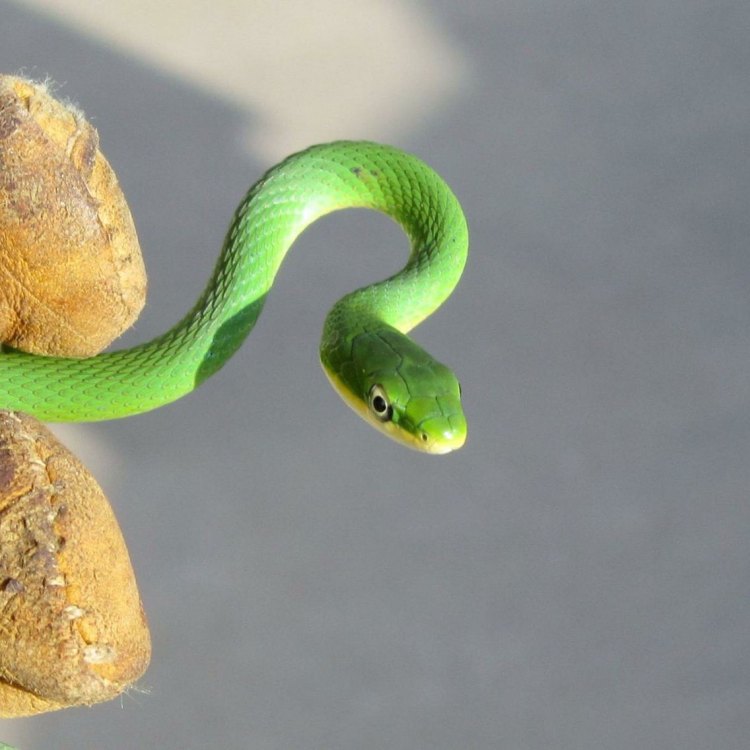
Rough Green Snake
- Adult Size: 2 to 4 feet (60 to 120 cm)
- Average Lifespan: 4 to 6 years
- Reproduction: Eggs
- Reproductive Behavior: Females lay 3 to 20 eggs in rotting logs or leaf litter
- Sound or Call: Generally silent, may make a soft hissing sound when threatened
- Migration Pattern: Non-migratory
- Social Groups: Solitary
- Behavior: Usually docile and non-aggressive
- Threats: Habitat loss, pesticide use, predation
- Conservation Status: Least Concern (IUCN)
- Impact on Ecosystem: Help control populations of insects and small invertebrates
- Human Use: Collected as pets, used in the pet trade
- Distinctive Features: Bright green coloration, smooth scales, large eyes
- Interesting Facts: Can jump from trees and glide to the ground using their long, slender bodies and flattened tails
- Predator: Birds, mammals, snakes
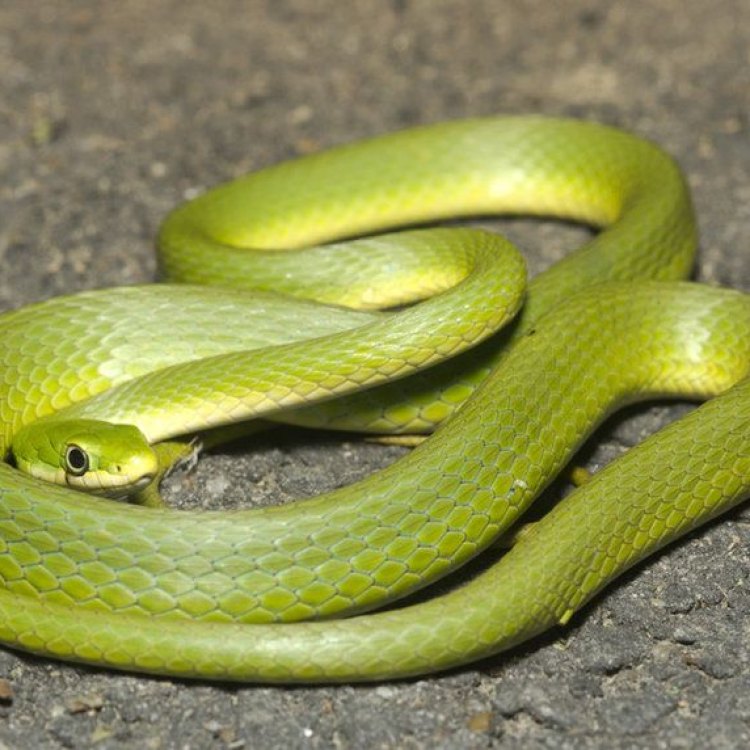
Opheodrys aestivus
The Green Guardian: A Look into the Life of the Rough Green Snake
Nestled in the dense foliage of eastern North America, the Rough Green Snake (Opheodrys aestivus) is a strikingly vibrant and fascinating creature. Its slender body, smooth scales, and large eyes make it easily recognizable among other species of snakes. But beyond its distinct appearance, there is much more to discover about this non-venomous reptile.With an adult size of 2 to 4 feet (60 to 120 cm), the Rough Green Snake is not particularly large PeaceOfAnimals.Com. However, its bright green coloration and graceful movements make it stand out in its natural habitat. It is commonly found in forests, woodlands, and grassy areas, where it can camouflage itself among the greenery.
The average lifespan of a Rough Green Snake is 4 to 6 years, though some have been known to live up to 8 years in captivity. Although not considered a long lifespan, these snakes make the most out of their short time on Earth.
Reproduction in Rough Green Snakes follows the typical egg-laying process of most snake species. During the warmer months, usually between April and July, females will lay 3 to 20 eggs in rotting logs or leaf litter. The eggs are then left to hatch on their own, without any parental care. Interestingly, the sex of the hatchlings is determined by the temperature at which the eggs are incubated - lower temperatures result in males, and higher temperatures result in females.
This species is generally silent, but they may make a soft hissing sound when threatened or disturbed Rabbit. This sound is produced by rapidly vibrating their tail against the ground or vegetation. However, it is not a common occurrence, and most encounters with these snakes are in silence.
Rough Green Snakes are non-migratory, meaning they do not undertake long-distance seasonal movements. They tend to remain in the same area throughout their lives, unless environmental factors such as food availability or harsh weather conditions force them to move.
These snakes are solitary creatures, and they are often found alone in their habitat. However, during the mating season, males may engage in combat to compete for females' attention. The winner will then mate with the female, and their paths will separate once again.
In terms of behavior, Rough Green Snakes are usually docile and non-aggressive towards humans. They can be easily handled and make popular pets due to their calm nature. However, they are also known to be highly sensitive to sudden movements and loud noises, so it is essential to handle them gently and with care.
While these snakes pose no real threat to humans, they do face various threats themselves. Habitat loss due to urbanization and agriculture is a significant issue for the Rough Green Snake. They prefer to live in areas with dense vegetation, which makes them vulnerable to development projects that destroy their homes.
Pesticide use also poses a significant threat to this species. Rough Green Snakes are insectivores, and they play a crucial role in controlling populations of insects and small invertebrates in their ecosystem. However, the use of pesticides in agricultural and residential areas can have detrimental effects on their food sources, causing a decline in their numbers.
Predation is another risk for Rough Green Snakes. These snakes are preyed upon by a variety of animals, including birds, mammals, and other snakes. They may also fall victim to cars while basking on roads, as their green color makes them difficult to spot.
Despite these threats, the Rough Green Snake is currently listed as Least Concern on the International Union for Conservation of Nature (IUCN) Red List of Threatened Species. This status is attributed to their wide range and relatively stable population.
Apart from their role in controlling insect populations, Rough Green Snakes also have a unique impact on the ecosystem. As prey for various predators, they help maintain the balance of the food chain. They also aid in seed dispersal through their droppings, contributing to the growth of new plants and trees in their habitat.
Humans have interacted with Rough Green Snakes for many years, often collecting them as pets or for use in the pet trade. While their docile nature may make them desirable as pets, it is crucial to remember that they are wild animals and require specific care and attention. In some states, it is also illegal to collect these snakes from the wild without a permit.
One of the most distinctive features of the Rough Green Snake is its bright green coloration. This color acts as camouflage, allowing them to blend in with their surroundings and avoid detection by predators. Their smooth scales also contribute to their agility and ability to move through dense vegetation with ease.
The large eyes of the Rough Green Snake also add to its unique appearance. These large, round eyes are essential for their survival as they have excellent vision, allowing them to spot potential predators and prey from a distance. It also helps them navigate through their environment and locate potential mates during the mating season.
Aside from its distinct appearance, the Rough Green Snake has some fascinating traits and behaviors. One of the most interesting facts about this species is their ability to jump from trees and glide to the ground using their long, slender bodies and flattened tails. This form of locomotion, known as "social gliding," allows them to move quickly and efficiently through their habitat, avoiding obstacles such as branches and rocks.
As mentioned earlier, Rough Green Snakes are primarily insectivores, feeding on a variety of insects and small invertebrates. However, they have also been known to eat small fish and frogs, adding some diversity to their diet.
Like most species of snakes, the Rough Green Snake has its fair share of predators. As mentioned earlier, they are preyed upon by birds, mammals, and other snakes. One of their main predators is the Eastern King Snake, a larger and more aggressive species that is immune to the venom of other snakes. The Rough Green Snake, being non-venomous, does not pose a threat to the Eastern King Snake.
In conclusion, the Rough Green Snake is a remarkable creature that plays a vital role in its ecosystem. With its bright green coloration, unique behaviors, and significant impact on the environment, it is truly a guardian of the forests. While it may face threats and challenges, its adaptability and resilience have allowed it to thrive and continue to enchant onlookers for many years to come.
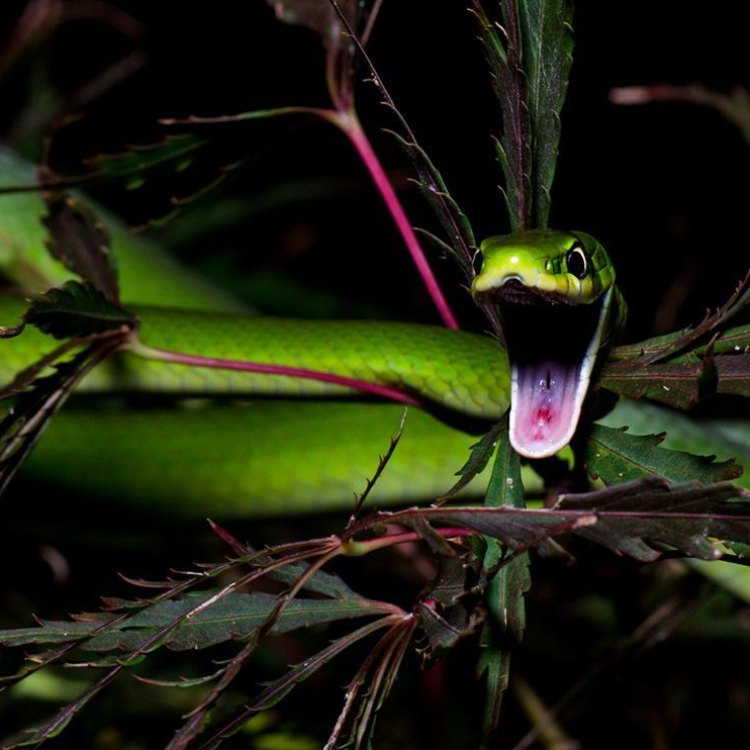
The Fascinating World of the Rough Green Snake
Disclaimer: The content provided is for informational purposes only. We cannot guarantee the accuracy of the information on this page 100%. All information provided here may change without prior notice.

